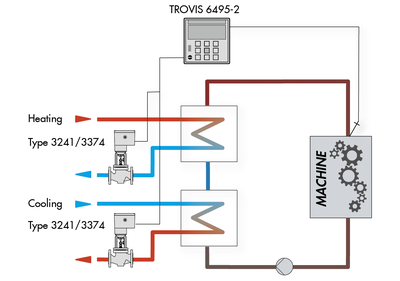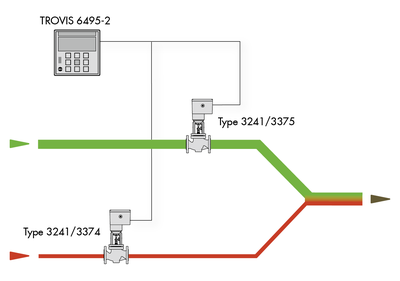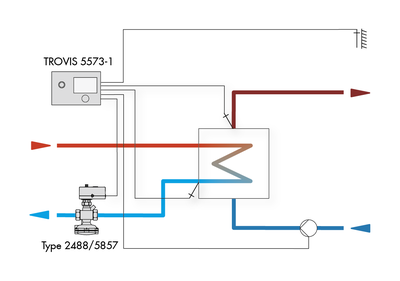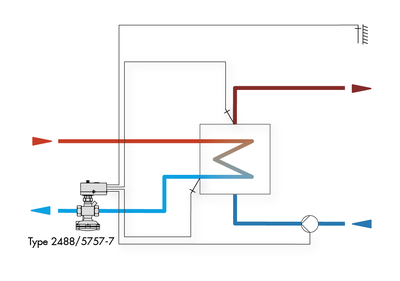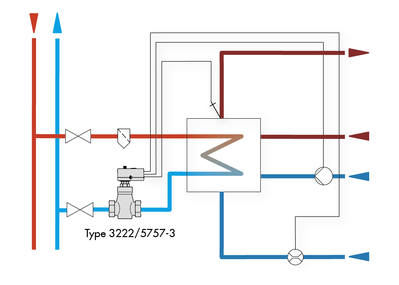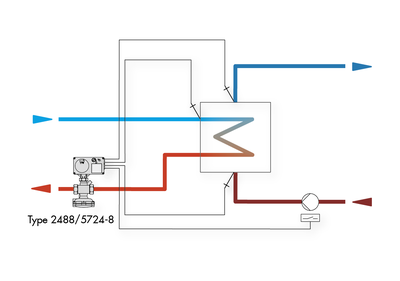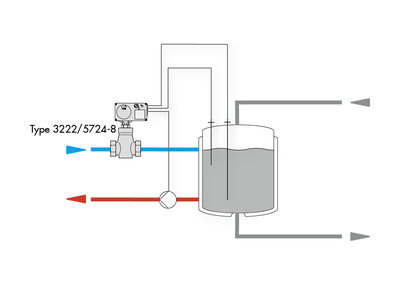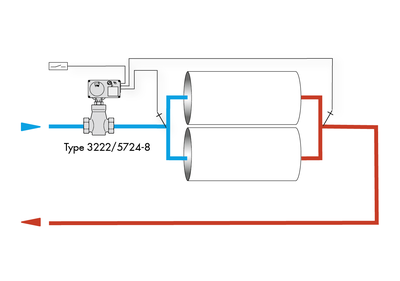Heating and cooling in sequence
Plants or machines frequently used in HVAC applications with changing temperature processes (heating and cooling) must either be heated or cooled depending on the ambient temperature. This is where the split-range function comes in handy, which is provided by the positioner integrated into the actuator: a single continuous control signal for the controller is fed to one actuator for heating and to a second actuator for cooling.
In the intermediate temperature range, none of the two actuators is active, both valves are closed.
Split-range operation (small or rated load)
For systems operating across wide load ranges, it makes sense to connect a valve with a low KV coefficient to handle small loads in parallel with a valve with high KV coefficient to handle the rated load. The actuators are controlled by a single continuous control signal, which initially causes the valve with the low KV coefficient to stroke to its maximum travel. After that, the control signal is fed to the valve with the high KV coefficient. To do so, the split-range function provided by the positioners in the two actuators is used.
Heating control using three-step actuators
Compact stations used in locat heat supply or district heating applications need a district heating controller that regulates the flow temperature in the heating system depending on the outdoor temperature. One of the essential requirements stipulated by district heating suppliers is that the return flow temperature fed back to the network is limited.
Heating control using electric actuators with process controllers
The application is as described on the previous page. In this application, however, the district heating controller and electric actuator are replaced by an electric actuator with process controller (e.g. TROVIS 5757-7) for heating and cooling applications. The controller has functions for outdoor temperature compensated control and return flow temperature limitation already implemented. In addition, it can directly switch a pump on and off.
DHW in instantaneous heating systems
Domestic hot water using instantaneous heating systems is the state-of-the-art way of supplying hot water for domestic use.
This type of control has two main requirements: quick measurement of the DHW temperature in the secondary flow pipe of the heat exchanger using quick-response sensors and a high stroking speed of the actuator.
The control system, which has a constant flow temperature, detects when hot water is being tapped and quickly controls the temperature on demand. The required controls are integrated into the SAMSON electric actuators with process controllers specifically designed for DHW, such as the TROVIS 5757-3.
District cooling transfer stations
In district cooling networks, the very compact TROVIS 5724-8 Electric Actuator with Process Controller can be used to control consumers in valve sizes up to DN 50. The associated, ready-wired application is configured such that the secondary flow temperature is controlled to a fixed set point, which also takes into account disturbances resulting from the primary flow (or network) temperature or the secondary return flow temperature.
Mash temperature control
When making wine, the temperature of the mash must be kept as constant as possible during the fermentation process. One option of controlling this process easily and at a reasonable price is to use a valve with a ready-configured TROVIS 5724-8 Electric Actuator with Process Controller to supply the required cooling energy. It is a compact unit for easy implementation of the fixed set point control with mean value calculation and pump control as required by the process.
Cooling water control
In industrial cooling processes, e.g. in calenders or machines with cooling rolls, the cooling water is often fed in at the full flow rate the whole time. To improve the energy efficiency of this process, a control unit comprising a TROVIS 5724-8 Electric Actuator with Process Controller and a suitable valve can be used. The flow rate is increased only when there is an actual cooling demand or when the measured temperature difference between the return flow and flow temperatures deviates from the rated temperature difference. At the same time, the return flow temperature can be monitored for excessive values and restricted as required.

